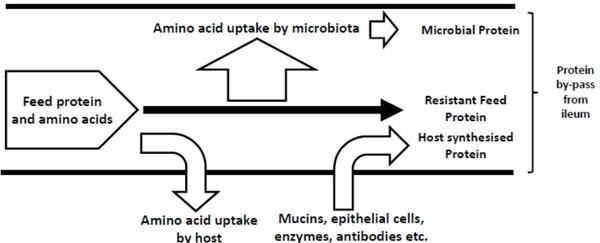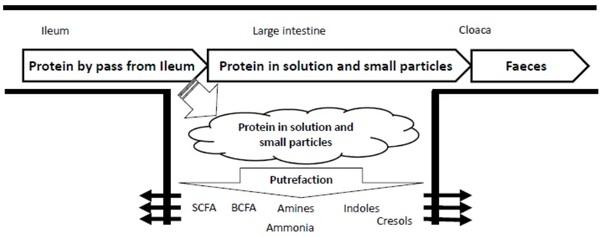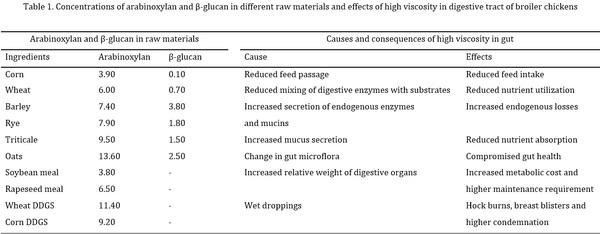Chicken gut microbiota: a brief understanding of the dynamics and interactions which govern flock performance







Abbas Hilmi H, Surakka A, Apajalahti J and Saris PEJ, 2007. Identification of the most abundant lactobacillus species in the crop of 1- and 5-week-oldbroiler chickens. Applied and Environmental Microbiology 73: 7867–7873.
Apajalahti J and Bedford MR, 1999. Improve bird performance by feeding its microflora. World Poultry, 15: 20-23
Apajalahti J, Kettunen A and Graham H, 2004. Characteristics of the gastrointestinal microbial communities, with special reference to the chicken. World’s Poultry Science Journal, 60: 223-232.
Apajalahti J and Kettunen A, 2006. Rational development of novel microbial modulators. In: Barug, D., de Jong, J., Kies, A.K. and Verstegen, M.W.A. (eds) Antimicrobial growth promoters. Where do we go from here? Wageningen Academic Publishers, Wageningen, Netherlands.
Apajalahti J and Vienola K, 2016. Interaction between chicken intestinal microbiota and protein digestion. Animal Feed Science and Technology, 221: 323-330.
Backhed F, 2011. Programming of host metabolism by the gut microbiota. Annals of Nutrition and Metabolism, 58: 44-52.
Barnes EM, Mead GC, Barnum DA and Harry EG, 1972. The intestinal flora of the chicken in the period 2–6 weeks of age, with particular reference to the anaerobic bacteria. British Poultry Science, 13: 311–326.
Bedford MR, 1995. Mechanism of action and potential environmental benefits from the use of feed enzymes. Animal Feed Science and Technology, 53: 145–155.
Bedford M, 2000. Removal of antibiotic growth promoters from poultry diets: implications and strategies to minimise subsequent problems. World’s Poultry Science Journal, 56: 347-365.
Bedford MR and Cowieson AJ, 2012. Exogenous enzymes and their effects on intestinal microbiology. Animal Feed Science and Technology, 173: 76–85.
Bjerrum L, Engberg RM, Leser TD, Jensen BB, Finster K and Pedersen K, 2006. Microbial Community Composition of the ileum and cecum of broilerchickens as revealed by molecular culture-based techniques. Poultry Science, 85: 1151–1164.
Brenes A, Smith M, Guenter W and Marquardt RR, 1993. Effect of enzyme supplementation on the performance and digestive tract size of broiler chickens fed wheat and barley based diets. Poultry Science, 72: 1731-1739.
Brown K, DeCoffe D, Molcan E and Gibson DL, 2012. Diet-induced dysbiosis of the intestinal microbiota and the effects on immunity and disease. Nutrients, 4: 1095-1119.
Carrasco JMD, Casanova NA and Miyakawa MEF, 2019. Microbiota, Gut Health and Chicken Productivity: What Is the Connection? Microorganisms, 7: 7, 374; doi:10.3390/microorganisms7100374.
Chan YK, Estaki M, Gibson DL, 2013. Clinical consequences of diet-induced dysbiosis. Annals of Nutrition and Metabolism, 63: 28–40.
Cowieson AJ and Kluenter AM, 2019. Contribution of exogenous enzymes to potentiate the removal of antibiotic growth promoters in poultry production. Animal Feed Science and Technology, 250: 81-92.
Cowieson AJ and Roos FF, 2016. Toward optimal value creation through the application of exogenous mono-component protease in the diets of non-ruminants. Animal Feed Science and Technology, 221: 331–340.
Donaldson EE, Stanley D, Hughes RJ and Moore RJ, 2017. The time-course of broiler intestinal microbiota development after administration of cecal contents to incubating eggs. Peer J, DOI: 10.7717/peerj.3587.
Eckburg PB, Bik EM, Bernstein CN, Purdom E, Dethlefsen L, Sargent M, et al., 2005. Diversity of the human intestinal microbial flora. Science, 308: 1635-1638.
Johnson TJ, Youmans BP, Noll S, Cardona C, Evans NP, Karnezos TP, Ngunjiri JM, Abundo MC and Lee CW, 2018. A consistent and predictable commercial broiler chicken bacterial microbiota in antibiotic-free production displays strong correlations with performance. Applied and Environmental Microbiology, 84: e00362-18.
Jurburg SD, Brouwer MSM, Ceccarelli D, van der Goot J, Jansman AJM and Bossers A, 2019. Patterns of community assembly in the developing chicken microbiome reveal rapid primary succession. Microbiology Open. DOI: 10.1002/mbo3.821.
Koenig JE, Spor A, Scalfone N, Fricker AD, Stombaugh J, Knight R, et al., 2011. Succession of microbial consortia in the developing infant gut microbiome. Proceedings of National Academy of Science U S A, 108: 4578-4585.
Kogut MH, Genovese KJ, Swaggerty CL, He H and Broom L, 2018. Inflammatory phenotypes in the intestine of poultry: not all inflammation is created equal. Poultry Science, 97: 2339–2346.
Kogut MH, 2019. The effect of microbiome modulation on the intestinal health of poultry. Animal Feed Science and Technology, 250: 32-40.
Lu J, Idris U, Harmon B, Hofacre C, Maurer JJ, and Lee MD. 2003. Diversity and succession of the intestinal bacterial community of the maturing broiler chicken. Applied and Environmental Microbiology, 69:6816–6824.
Matamoros S, Gras-Leguen C, Le Vacon F, Potel G and de La Cochetiere MF, 2013. Development of intestinal microbiota in infants and its impact on health. Trends in Microbiology, 21: 167-173.
Morgan NK, Walk CL, Bedford MR and Burton EJ, 2014. The effect of dietary calcium inclusion on broiler gastrointestinal pH: Quantification and method optimization. Poultry Science Association, 93: 354–363.
Muramatsu T, Nakajima S and Okumura J. 1994. Modification of energy metabolism by the presence of the gut microflora in the broiler chicken. British Journal of Nutrition, 71: 709-717.
Oakley BB, Lillehoj HS, Kogut MH, Kim WK, Maurer JJ, Pedroso A, et al., 2014. The chicken gastrointestinal microbiome. FEMS Microbiology Letters, 360(2):100–12. doi:10.1111/1574-6968.12608.
Oakley BB and Kogut MH, 2016. Spatial and temporal changes in the broiler chicken cecal and fecal microbiomes and correlations of bacterial taxa with cytokine gene expression. Frontiers in Veterinary Science, 3: doi: 10.3389/fvets.2016.00011.
Oakley BB, Vasconcelos EJR, Diniz PPVP, Calloway KN, Richardson E, Meinersmann RJ, Cox NA and Berrang ME, 2018. The cecal microbiome of commercial broiler chickens varies significantly by season. Poultry Science, 10: 3635–3644.
Oviedo-Rondón EO, 2019. Holistic view of intestinal health in poultry. Animal Feed Science and Technology, 250: 1-8.
Palmer C, Bik EM, DiGiulio DB, Relman DA and Brown PO, 2007. Development of the human infant intestinal microbiota. PLoS Biology 5: e177.
Qin J, Li R, Raes J, Arumugam M, Burgdorf KS, Manichanh C, et al., 2010. A human gut microbial gene catalogue established by metagenomic sequencing. Nature 464: 59-65.
RodrÍguez JM, Murphy K, Stanton C, Paul Ross R, Kober OI et al., 2015. The composition of the gut microbiota throughout life, with an emphasis on early life. Microbial Ecology in Health and Disease, 26: 26050 - http://dx.doi.org/10.3402/mehd.v26.26050.
Roto SM, Rubinelli PM, and Ricke SC, 2015. An introduction to the avian gut microbiota and the effects of yeast-based prebiotic compounds as potential feed additives. Frontier in Veterinary Science, 2:28.doi: 10.3389/fvets.2015.00028.
Round JL and Mazmanian SK, 2009. The gut microbiota shapes intestinal immune responses during health and disease. Nature Reviews Immunology, 9: 313–323.
Rychlik I, 2020. Composition and Function of Chicken Gut Microbiota. Animals, 10, 103; doi:10.3390/ani10010103.
Salanitro J P, Blake IG, Muirehead PA, Maglio M, and Goodman JR, 1978. Bacteria isolated from the duodenum, ileum, and cecum of young chicks. Applied and Environmental Microbiology, 35:782–790.
Shang Y, Kumar S, Oakley B and Kim WK, 2018. Chicken Gut Microbiota: Importance and Detection Technology. Frontiers in Veterinary Science, 5:254. doi: 10.3389/fvets.2018.00254.
Silva SSP and Smithard RR, 1996. Exogenous enzymes in broiler diets: crypt cell proliferation, digesta viscosity, short chain fatty acids and xylanase in the jejunum. British Poultry Science 37 (Supplement): 577-79.
Stanley D, Geier MS, Denman SE, Haring VR, Crowley TM, Hughes RJ and Moore RJ, 2013. Identification of chicken intestinal microbiota correlated with the efficiency of energy extraction from feed. Veterinary Microbiology, 164: 85-92.
Weiss A and Hennet T, 2017. Mechanisms and consequences of intestinal dysbiosis. Cellular and Molecular Life Sciences, 74: 2959–2977.
Yatsunenko T, Rey FE, Manary MJ, Trehan I, Dominguez-Bello MG, Contreras M, et al., 2012. Human gut microbiome viewed across age and geography. Nature 486: 222-227.
Zhang YJ, Li S, Gan RY, Zhou T, Xu DP and Li HB, 2015. Impacts of Gut Bacteria on Human Health and Diseases. International Journal of Molecular Science, 16: 7493-7519.

Use of Probiotics in Poultry Production.??
1. In recent years, probiotics have become more popular in the world of dietary supplements and feed additives within the poultry .??
2. The statement “immunity comes from the intestines” has become more important in the poultry industry because probiotics have proven helpful in the fight against diseases of bacterial origin and against zoonoses. ???
3. Future prospects for probiotics are promising as preparations with more strains are increasingly being studied, as well as interactions between them.??
4. CosBac of ABTL is Bacillus Subtilis along with other species & prebiotics and is poultry industry modern tool in maintaining gut integrity and reduce mortality.
Dr V.Rajendra Prasad


United States







